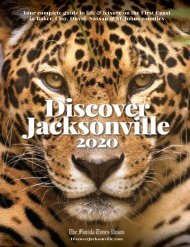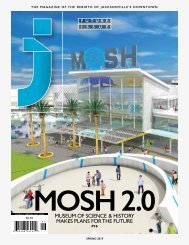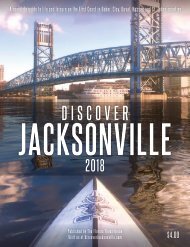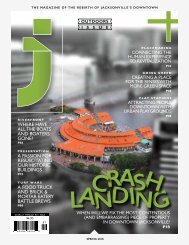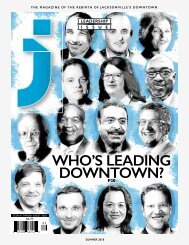J Magazine Winter 2019
Create successful ePaper yourself
Turn your PDF publications into a flip-book with our unique Google optimized e-Paper software.
that runs smarter and leaner by plugging<br />
its assets into the Internet of Things. In that<br />
broader tale, The Innovation Corridor is<br />
neither the first act nor that final scene.<br />
The Internet of Things has been quietly<br />
developing in Jacksonville for over a decade.<br />
Its future is much larger than a 3-mile stretch<br />
of Downtown roadway.<br />
North Florida gets smart<br />
The Internet’s worldwide network of<br />
computers and devices has for decades<br />
provided information to people. Now the Internet<br />
is being used for things to provide information<br />
to other things. Any object armed<br />
with a sensor and a microchip can collect<br />
data about its environment and broadcast it<br />
to the Internet.<br />
The more objects get connected to one<br />
another this way, the more they can react<br />
to things around them without human<br />
intervention. When the Internet of Things is<br />
used to perform municipal services, that city<br />
is called a Smart City. Parking spaces can tell<br />
you when they are empty. Trashcans can tell<br />
you when they are full.<br />
The Internet of Things seems incredible,<br />
but it’s also believable. That’s because it’s<br />
already happening in Jacksonville.<br />
For years the North Florida Transportation<br />
Planning Organization has been using<br />
swaths of remote sensors to collect bits of<br />
traffic data. It all started 15 years ago, long<br />
before the Internet of Things was…well, a<br />
thing.<br />
“We needed transit to become more<br />
efficient,” said Jeff Sheffield, executive<br />
director of the TPO. “We are not going to be<br />
able to build enough roads to fulfill all of our<br />
transportation needs.”<br />
So, transportation engineers deployed<br />
hundreds of infrared sensors and Bluetooth<br />
receivers along highways. The pings<br />
of data the TPO now collects from moving<br />
vehicles feed a traffic app that tells commuters<br />
which route to work is quickest. The<br />
data also inform those smart highway signs<br />
that warn travelers of a disabled vehicle<br />
ahead.<br />
Mission control for all of this traffic data<br />
is a little known facility on Jefferson Street<br />
— a 6,500-square-foot Regional Transportation<br />
Management Center. Sheffield<br />
stands in the middle of it, arms outstretched<br />
as he presents the achievement.<br />
The floor is divided into workplace<br />
“pods,” each with its own array of computer<br />
terminals. The walls of the room are lined<br />
at both ends with monitors.<br />
Some display live feeds from Interstate<br />
Highway traffic cameras. Others light up<br />
highway routes in green, yellow and red,<br />
according to congestion. One tracks the<br />
GPS position of Road Rangers — a fleet<br />
of repair trucks that respond when a car<br />
breaks down on the highway. Another<br />
monitor lists wind speeds on bridges.<br />
“If conditions go out of the norm, an<br />
alarm is sent to the relevant agency,” Sheffield<br />
said. “They don’t have to watch every<br />
minute.”<br />
All of this input helps the TPO with its<br />
operations, certainly. From this building,<br />
transportation managers can reprogram<br />
stoplights remotely, aligning them with<br />
measured shifts in traffic demand.<br />
The real power of the Internet of Things<br />
happens when data is shared, though,<br />
Sheffield said. He makes a case that’s already<br />
begun, though in an analog kind of a way.<br />
The Jacksonville Sheriff’s Office, Florida<br />
Highway Patrol, Fish and Wildlife and state<br />
Department of Transportation all maintain<br />
teams at the transportation center.<br />
“It helps them to react a little bit sooner,”<br />
Sheffield said. “We found with first responders,<br />
all of us are asking a lot of the same<br />
questions.”<br />
When an accident occurs, police can<br />
dispatch officers to the scene. During a hurricane,<br />
winds can be measured, evacuations<br />
can be managed and incidents monitored.<br />
The data from the Regional Transportation<br />
Management Center connect to a larger<br />
statewide network, too. When Hurricane<br />
Dorian threatened South Florida last summer,<br />
the Florida Department of Transportation<br />
evacuated its transportation management<br />
center in Miami and relocated the staff<br />
to Jacksonville. From that safe distance they<br />
could “listen” to pings of data from South<br />
Florida sensors.<br />
Petri dish for a Smart Region<br />
Today’s accomplishments are just one<br />
small step toward the Internet of Things. The<br />
giant leap is still to come.<br />
The North Florida TPO has teamed with<br />
the cities of Jacksonville and St. Augustine,<br />
the JTA and more than 100 public and<br />
private partners to form a Smart Region<br />
Coalition. Its aim is to transform Northeast<br />
Florida into a place [Continued on page 97]<br />
BOB SELF<br />
Jeff Sheffield, Executive Director of the North<br />
Florida TPO, stands at a bank of monitors showing<br />
real time traffic camera feeds and other traffic data<br />
at the operations center on North Jefferson Street.



